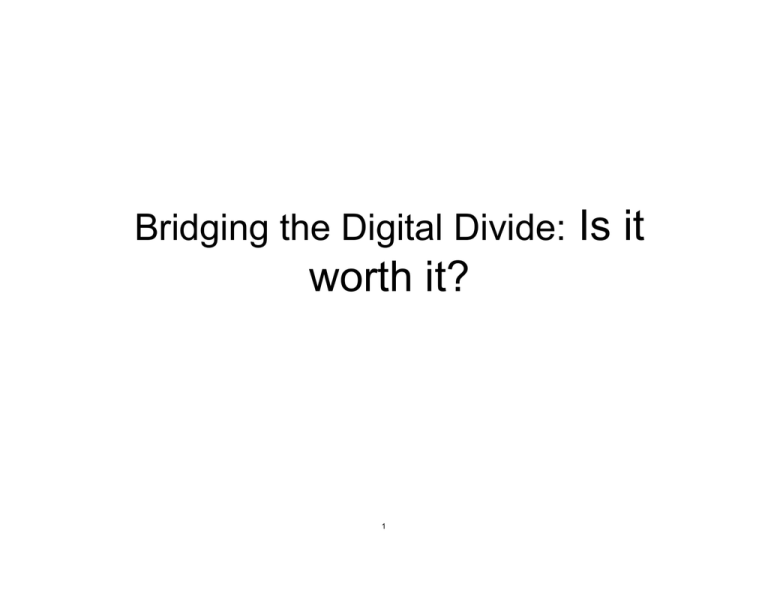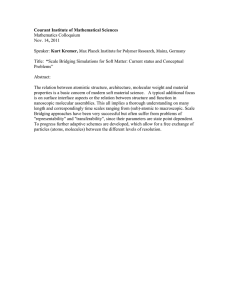Is it worth it? Bridging the Digital Divide: 1
advertisement

Bridging the Digital Divide: Is it worth it? 1 What is the Digital Divide • The digital divide is a social/political issue referring to the socio-economic gap between communities that have access to Information and Communication Technologies (ICT) and those that do not. • The term also refers to gaps that exist between groups regarding their ability to use ICTs effectively, due to their geographic location, their living standard, differing levels of literacy and technical skills, as well as the gap between those groups that have access to quality, useful digital content and those that do not.[1][2] [1] http://en.wikipedia.org/wiki/Digital_divide [2]http://www.alcatel.com/doctypes/articlepaperlibrary/pdf/ATR2004Q3/S0408-Bridging_opportunityEN.pdf by Souhiel Marine and Jean Marie Blanchard Alcatel Telecommunications Review - 3rd Quarter 2004 2 Bridging the Digital Divide How? – National Policies - telephone: US national policy on Universal telephone access – International Policies – UN Millennium Declaration, WSIS (the goals) – Organizational Policies – MIT’s OCW – Individuals - MIT AITI, Camp Amelia, 3 Is it worth it? • We interpreted this question as: Do the benefits outweigh the economic investment, and the human effort, that go into bridging the digital divide? 4 Reasons for Bridging the Digital Divide In General Bridging the Digital divide will be advantageous to Individuals, Nations and the Global Community as a whole • Academic Advancement and SelfImprovement • Economic Growth • Democracy • Social and Economic Equality 5 How & why Bridging the Digital Divide has worked • How wireless internet Technology has helped fishermen and farmers in Senegal 6 Concerns of Bridging The Digital Divide 1. Economic Concerns 2. Evaluating the Sustainability 3. Setting Priorities 7 The Actual Bridging of The Digital Divide 1. Economic Concerns • Somebody has to pay more than their share. 2. Evaluating the Sustainability 3. Setting Priorities 8 The Actual Bridging of The Digital Divide 1. Economic Concerns 2. Evaluating the Sustainability • -“Jumping in too fast can lock in a technology that soon would be superseded by a better one.“ -Benjamin M. Compaine -Telegraph or DC electric current 3. Setting Priorities 9 The Actual Bridging of The Digital Divide 1. Economic Concerns 2. Evaluating the Sustainability 3. Setting Priorities • “The issue is not one of information or knowledge gaps, any more than it is one of a protein gap or a transportation gap." -Benjamin M. Compaine 10 The Actual Bridging of The Digital Divide • “Go Slow” position -> Not rushing. -> Research more before actually start bridging. -> Can resolve, 1. Economic Concerns 2. Evaluating the Sustainability 3. Setting Priorities 11 Case Studies • French government: Videotext ->Should have chosen “Go Slow” position. • Telephone Industry ->“Go Slow” position worked. • International Donor Project to an Egyptian University. ->Unpredicted result. 12 History of Telephone Industry 1. Private development from Alexander Graham Bell. (Monopoly) 2. A period of competition with some other companies 3. Then government approved and regulated monopoly 4. Now, a period of regulated competition. • The role of government to bridge the digital divide of telephone was pursued decades after telephone service began. • Without so much effort of the government, the digital divide of telephone is bridged. 13 What does it boil down to? • Deciding on whether Bridging the Digital divide is worth it is difficult. The proponents of it being worth it are thinking about the Long Term benefits to the people, nation or the world. Whereas those who are against it are concerned more about the short term/immediate solutions to the problems that people in underprivileged communities face. 14 Suggestions & Conclusion • The Question that we were tackling in this presentation is, are efforts to bridge the digital divide worth it? • The Illustrations and Case Studies provided show that for each particular case there is a certain set of circumstances that make it possible or impossible to bridge the digital divide. Thus implementation of any policies must go with a high level of thought, research and study of the peculiar community and the sustainability of the particular technological tool 15 MIT OpenCourseWare http://ocw.mit.edu 21G.034 / CMS.930 Media Education and the Marketplace Fall 2005 For information about citing these materials or our Terms of Use, visit: http://ocw.mit.edu/terms.



